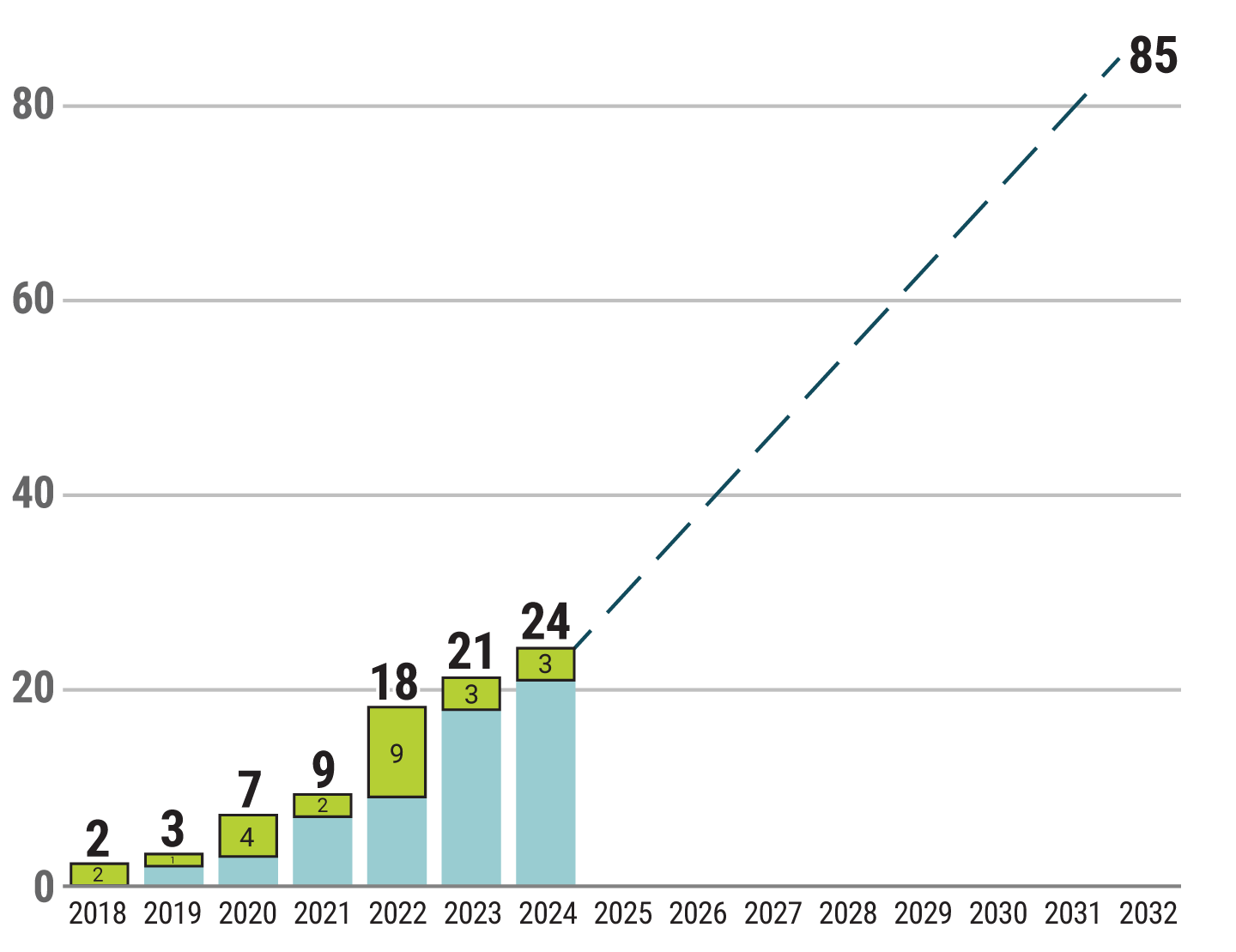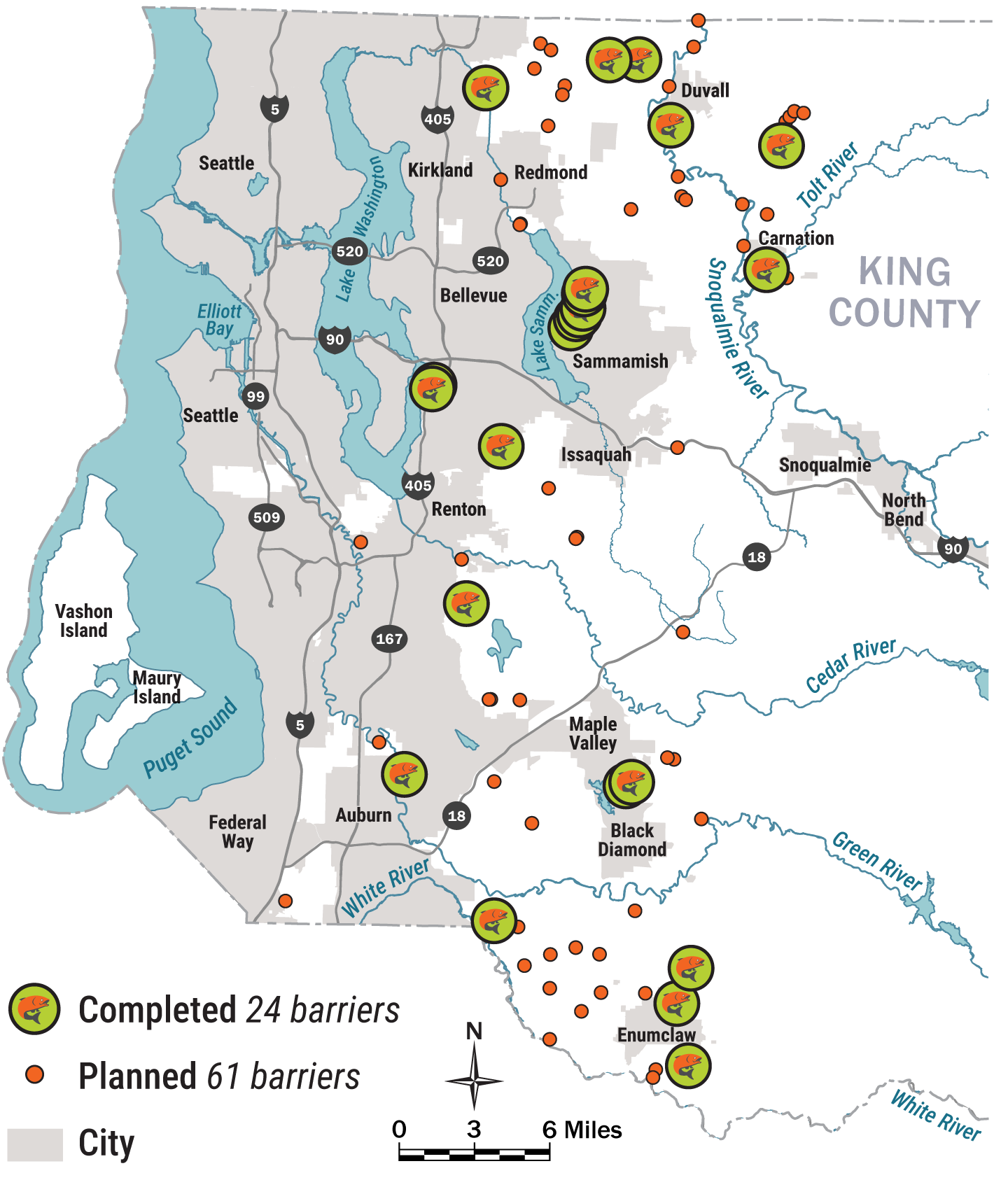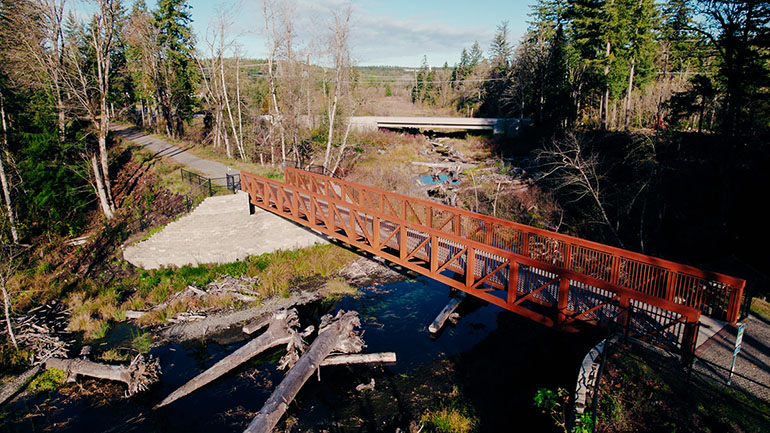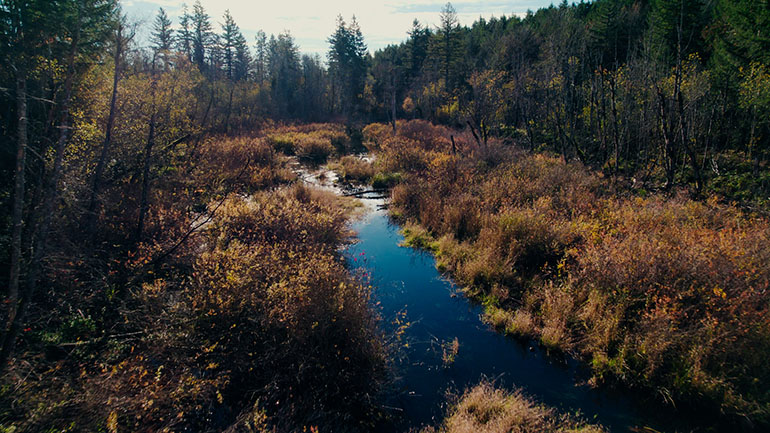VIDEO: Executive Constantine’s budget proposal builds on King County’s momentum for removing barriers to high-quality salmon habitat while restoring ecological functions
Summary
Nov. 14, 2024: King County is off to a strong start restoring access to historic salmon habitat while also making county roads safer and offering more outdoor recreation opportunities. Executive Constantine’s proposed 2025 budget would maintain that accelerated pace.
News
King County Executive Dow Constantine’s proposed budget would maintain King County’s accelerated pace for removing barriers to high-quality habitat, one of the most effective ways to help ensure the survival of native salmon and the southern resident orcas that rely on them as a food source.
The $9 million funding proposal in the 2025 budget would keep King County on track to restore access to more than 300 miles of historic habitat within a decade. The county has opened access to 42 miles of historic habitat since Executive Constantine launched the restoration program in 2018.
King County’s approach unifies investments to produce multiple benefits for people, fish, and wildlife. For example, a successful project along Ravensdale Creek replaced a century-old culvert with a new trail bridge. King County Parks, meanwhile, transformed the surrounding 1,200 acres from a degraded landscape into dynamic, healthy habitat that features restored forestland, backcountry trails, and a scenic bridge offering views of increased wildlife activity.
“Our work to remove barriers to high-quality habitat is off to a strong start, guided by science to target the best opportunities,” said Executive Constantine. “By clearing barriers so salmon can reach their historic habitat, we’re also making county roads safer, restoring natural ecosystems, and creating new outdoor recreation opportunities.”
The County Council is expected to vote on Executive Constantine’s proposed budget by the end of this month.
On track to complete fish passage projects

King County fish passage projects

King County – consulting with Tribes and partners – determined which barriers preventing salmon passage to restore based on the results of a three-year field study conducted by scientists and engineers. After ranking nearly 1,000 barriers, the field team determined that fixing about 5% of the barriers currently blocked by county roads and trails – about 50 restoration projects – would reopen access to at least half the habitat.
By prioritizing restoration projects based on the greatest benefits for salmon, King County’s Fish Passage Restoration Program is on track to achieve in a decade what would take a century to complete if restoration projects were randomly selected.
A unified approach that produces results for people, fish, and wildlife
A completed project along Ravensdale Creek near Maple Valley reflects King County’s unified approach that capitalizes on partnerships and produces multiple benefits.
A state grant helped the county replace a small, obsolete culvert with a trail bridge located a few hundred feet from a new state highway bridge that restored upstream access, making it possible for salmon to easily navigate their historic habitat. Between the two new bridges, the county removed another obsolete culvert and restored the natural stream channel.

King County Parks – with funding from the King County Parks Levy – transformed the surrounding area that was clear cut multiple times over the past century. A landscape that 10 years ago was covered in noxious weeds and had little ecological value now features restored forestland with native vegetation that cools salmon-bearing streams. Beavers built dams that add habitat complexity, store winter floods, and provide cool waterflows during summer, benefiting fish and wildlife.
King County Parks also expanded its nearby backcountry trail network, which connects to the future Green to Cedar Rivers Trail. Crews used a helicopter to install a wooden bridge that crosses Ravensdale Creek, downstream of the county’s new steel trail bridge.
"We design and enhance parks and trails that benefit both people and the environment,” said King County Parks Director Warren Jimenez. “In natural areas throughout King County, we’re simultaneously increasing access to outdoor recreation and restoring ecological functions.”

King County Roads Services – a division of the Department of Local Services – has contributed to early progress at other locations, including recent restoration projects on Northwest Woodinville-Duvall Road near Duvall and on Southeast 432nd Avenue near Enumclaw that replaced obsolete culverts that blocked salmon from upstream habitat.
Replacing obsolete culverts under county-owned roads also increases safety and reliability for motorists.
“Many of our improvement projects make roads in unincorporated King County more reliable for people and provide healthy habit for salmon,” said Tricia Davis, Director of King County Road Services. “By working closely with other King County divisions, Tribes, and partners we’re showing how collaboration can deliver more benefits for every public dollar we invest.”
Unifying investments across multiple King County departments and divisions to produce multiple benefits for people, fish, and wildlife is the centerpiece of Clean Water Healthy Habitat, an initiative Executive Constantine launched in 2019.
"Our employees have the remarkable ability to achieve multiple objectives in a single natural area,” said John Taylor, Director of the King County Department of Natural Resources and Parks. “They see more than barriers to historic salmon habitat that need to be fixed – they see opportunities to transform the landscape for the benefit of people, fish, and wildlife.”
Multimedia
- VIDEO: Strong start for removing barriers to salmon habitat
- VIDEO: Identifying the best opportunities to remove barriers to salmon habitat
- PHOTO GALLERY: Removing barriers to high-quality salmon habitat
- TRACKS: An interactive map of environmental stewardship led by King County
Resources
Quotes
Our work to remove barriers to high-quality habitat is off to a strong start, guided by science to target the best opportunities. By clearing barriers so salmon can reach their historic habitat, we’re also making county roads safer, restoring natural ecosystems, and creating new outdoor recreation opportunities.
Our employees have the remarkable ability to achieve multiple objectives in a single natural area. They see more than barriers to historic salmon habitat that need to be fixed – they see opportunities to transform the landscape for the benefit of people, fish, and wildlife.
Many of our improvement projects make roads in unincorporated King County more reliable for people and provide healthy habit for salmon. By working closely with other King County divisions, Tribes, and partners we’re showing how collaboration can deliver more benefits for every public dollar we invest.
We design and enhance parks and trails that benefit both people and the environment. In natural areas throughout King County, we’re simultaneously increasing access to outdoor recreation and restoring ecological functions.
Contact
Doug Williams, Department of Natural Resources and Parks, 206-477-4543
Visit our Newsroom for additional resources

 Translate
Translate